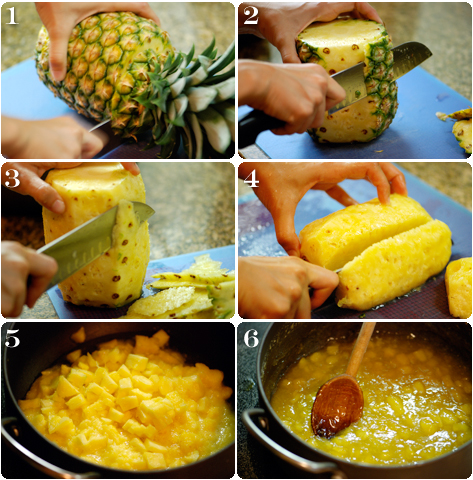Pie crust can be daunting. I know numerous cooks, professional and amateur, that don’t relish the thought of making it. I’ve always found making pies a soothing activity, but did have a lousy, nightmarish episode with crusts recently that almost made me break out in hives. Anyway. I won’t make you break out into hives or develop an eye twitch. This pie crust lesson is tedious and longer than the recipes I’ve been posting lately, but holiday season is fast approaching and maybe you’d like to try your hand at it, get some practice, so you can bring something “wow” to your family dinner this year.
HOW TO MAKE PIE CRUST
I rarely cook or provide recipes using the metric system, however, when it comes to pie crust I dutifully unwrap my scale and press the “grams” button. I’ve translated the measurements to cups and tablespoons, but I do prefer the certainty of the scale.
The following recipe is applicable only to the pastel de piña (pineappple pie) that follows. I read and reread my mother’s recipe for the Nicaraguan bakery staple, and unconventional as it is, it’s traditional. Normally, a tart or single crust pie such as lemon meringue is made by “blind” baking the crust: the tart mold or pie plate is lined with pie dough which is pricked to prevent puffing, lined with parchment or foil, weighed down, and baked prior to being cooled and filled. A double-crust pie like apple pie is filled raw: the pie plate is lined with pie dough, filled, and topped with a second, vented crust or with a latticed top, then baked.
Pastel de piña uses an unorthodox combination of the two methods: the crust is blind baked, filled, then topped with a lattice and returned to the oven.
PÂTE BRISÉE with EGG
Makes a double-crust for an 8- to 9-inch pie
Don’t skip any of the resting or chilling periods in the recipe, unless you want a shriveled, shrunken, or tough crust!
400 grams (2 ¾ cups) all-purpose flour
1 teaspoon salt
200 grams (15 tablespoons) chilled butter cut into ¼ inch pieces
2 eggs, lightly beaten
Ice water, as needed
1 egg yolk
2 teaspoons heavy cream
Pinch of salt
– Combine the flour and salt on a clean, dry work surface. With a bench scraper, cut in the butter until it resembles wet sand. Alternatively, combine the flour and salt in the bowl of a food processor and add the butter. Pulse until the mixture resembles wet sand, then transfer mixture to a clean, dry work surface.
– Form a well in the center of the flour mixture and pour in the eggs plus 1 tablespoon ice water.
– Working quickly, use the bench scraper to cut in the eggs and water. If the mixture appears very dry and crumbly, add water, 1 teaspoon at a time, until the mixture is cohesive but not overly wet.
– Bring the dough together with your hands. Pinch off pieces of dough (about 2-inch pieces) and with the heel of your hand extend on the surface. This method, called fraisage, ensures that the butter is evenly distributed in the dough. Shape the dough into a ball and cut it in half. Shape each half into a disc and wrap in plastic. Refrigerate for 30 minutes.
– On a lightly floured surface, roll the dough out to about 10 inches in diameter. Gently fold the dough into quarters and transfer to an 8-inch tart shell. Unfold the dough and press it into the shell. Trim off excess overhang and lightly prick all over with fork. Transfer the lined shell to refrigerator and chill 30 minutes, then, freeze for 20 minutes. Preheat the oven to 375˚F.
– Roll out the second dough disc on a piece of lightly floured parchment paper to 10 inches in diameter and cut into 8 1-inch-thick strips. Slide parchment and strips onto a baking sheet or jelly board and refrigerate.
– Line the chilled shell with foil or parchment paper (not wax paper!) and fill with pie weights or dry beans. Bake until the dough looks opaque, 20 to 25 minutes.
– Fill the pie shell with the pineapple mixture (see recipe below). Following photo 13, lay out four dough strips across the pie at about 1-inch intervals. Then, starting in the middle, lay one additional strip perpendicular to the original strips. Carefully weave the strips into each other, following figures 13 to 16.
– Beat the egg yolk, cream, and salt in small bowl. With a pastry brush, paint the egg mixture over the lattice top. Bake until golden, 30 to 40 minutes. Transfer pie to wire rack and cool to room temperature, 1 to 2 hours.
PASTEL DE PIÑA
Serves 6 to 8
1 large, ripe pineapple
½ cup water
2 tablespoons cornstarch
1 ½ cups sugar
1/8 teaspoon salt
4 tablespoons unsalted butter, cut into 1 inch pieces
– With a chef’s knife, cut off the crown of leaves and about 1 inch from the base. Stand the pineapple upright and cut the prickly exterior off. If there are any “eyes” left, trim them.
– Lay the pineapple on its side and cut the flesh off; discard the core. Cut the pineapple into ½-inch pieces.
– Transfer half of the pineapple chunks to a food processor and pulse until pineapple is a thick puree.
– Transfer to a large pot.
– Whisk cornstarch and water together in a small bowl and stir into pineapple. Stir in the sugar and salt.
– Bring the pineapple mixture to a boil and simmer, stirring occasionally, until deep golden and jam-like, 45 to 60 minutes. Off heat, stir in butter.
– Fill the blind baked crust and continue to recipe above.

